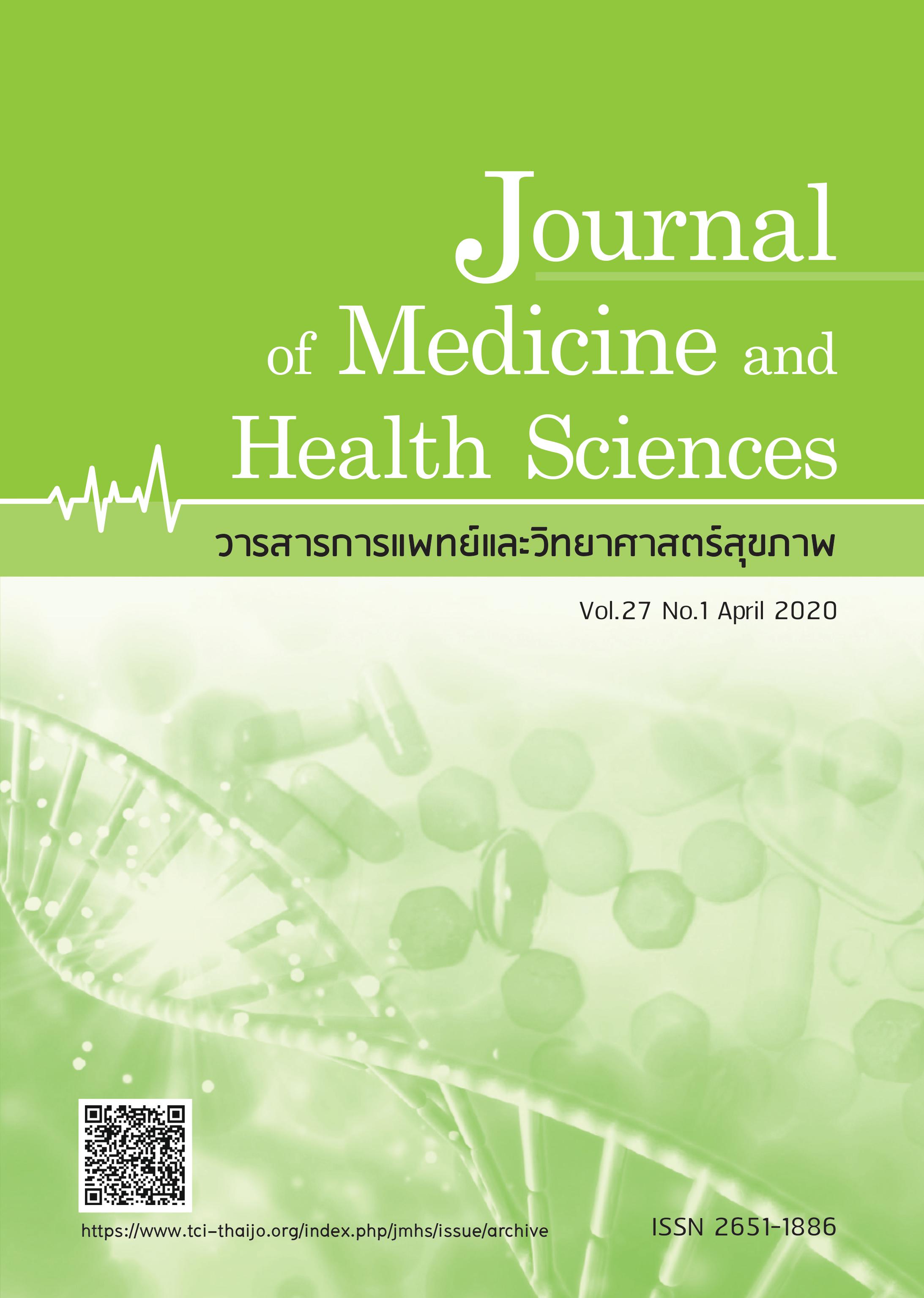คุณค่าโภชนาการของอาหารที่บริโภคและพฤติกรรมการบริโภคอาหาร ของเด็กวัยเรียนชาวเขา จังหวัดพะเยา
คำสำคัญ:
คุณค่าโภชนาการอาหารบริโภค, พฤติกรรมการบริโภคอาหาร, นักเรียนชาวเขาบทคัดย่อ
บทคัดย่อ
งานวิจัยนี้เป็นการศึกษาแบบตัดขวางที่ได้ทำการศึกษาในเดือนพฤษภาคม 2560 มีวัตถุประสงค์เพื่อประเมินคุณค่าโภชนาการอาหารบริโภคและศึกษาพฤติกรรมการบริโภคอาหารของเด็กวัยเรียนชาวเขา จังหวัดพะเยา ผู้เข้าร่วมวิจัยเป็นนักเรียนชาวเขาจำนวน 193 คน ที่กำลังศึกษาโรงเรียนระดับชั้นประถมศึกษาปีที่ 5 และ 6 (อายุ 10-11 ปี) ใน 6 โรงเรียน สังกัดสำนักงานเขตพื้นที่การศึกษาพะเยา เขต 2 ผู้วิจัยใช้แบบสอบถามความถี่พฤติกรรมการบริโภคอาหารและการบริโภคอาหารย้อนหลัง 24 ชั่วโมง เพื่อให้ได้ข้อมูลการบริโภคอาหาร จากนั้นข้อมูลการบริโภคอาหารจะถูกนำมาวิเคราะห์คุณค่าทางโภชนาการด้วยโปรแกรมวิเคราะห์คุณค่าโภชนาการ (อินมูแคล รุ่น 3.0) ผลการศึกษาพบว่า พลังงานที่ผู้เข้าร่วมวิจัยได้รับจากการบริโภคอาหารเท่ากับ 708.86±343.33 กิโลแคลอรี่ และการกระจายพลังงานจากคาร์โบไฮเดรต โปรตีน และไขมัน เท่ากับร้อยละ 51.90±14.16 ร้อยละ 18.16±6.41 และร้อยละ 28.04±10.68 ของพลังงานทั้งหมดตามลำดับ ขณะที่แร่ธาตุอื่นพบว่า เด็กนักเรียนชาวเขาส่วนใหญ่ได้รับแคลเซียมและธาตุเหล็กจากการบริโภคอาหารในปริมาณต่ำ เท่ากับ 193 คน (ร้อยละ 100.0) และ186 คน (ร้อยละ 96.0) ตามลำดับ นอกจากนี้ ผู้เข้าร่วมวิจัยมีพฤติกรรมการบริโภคที่ชอบดื่มนมปรุงแต่งรส ร้อยละ 76.0 ชอบบริโภคขนมขบเคี้ยวกรุบกรอบ ร้อยละ 69.0 และมีนักเรียนชาวเขาเพียง ร้อยละ 25.0 ที่บริโภคผักผลไม้เป็นประจำ งานวิจัยสรุปได้ว่า เด็กนักเรียนชาวเขา ได้รับพลังงานจากการบริโภคอาหารไม่เพียงพอกับความต้องการ และขาดวิตามินแร่ธาตุสำคัญ เช่น แคลเซียม และธาตุเหล็ก ดังนั้น เด็กชาวเขาควรได้รับการส่งเสริมให้บริโภคอาหารที่อุดมด้วยสารอาหาร โดยเฉพาะอย่างยิ่ง การบริโภคแหล่งโปรตีนที่มีคุณภาพดีจะช่วยให้เด็กมีร่างกายแข็งแรงและเรียนรู้ได้ดี ข้อจำกัดงานวิจัยคือ การเดินทางเข้าพื้นที่ที่อยู่บนเขาลาดชันในฤดูฝน ซึ่งทำให้ไม่สามารถเข้าเก็บข้อมูลได้ อย่างไรก็ตาม ข้อมูลจาก งานวิจัยนี้จะเป็นข้อมูลพื้นฐานในการวางแผนนโยบายด้านสุขภาพของครอบครัวและชุมชนสำหรับชาวเขา ให้มีสุขภาพดีในอนาคตต่อไป
Abstract
This research is a cross-sectional study in May 2017. The objective is to evaluate the nutritional values of dietary intake and to study food consumption behaviors among the hill tribe school-ages at Phayao province. The participants are hill tribe students 193 people who are studying elementary school grade 5 and 6 (10-11 years old) in 6 schools under Phayao primary educational service area office 2. Researchers used food frequency questionnaires and 24 hours dietary recall to obtain a food consumption data. Then, the dietary intake data was analyzed the nutrition values with nutrition value analysis program (INMUCAL, version 3.0). The results revealed that energy intake of participants was 708.86±343.33 kcal and energy distribution of carbohydrates, proteins and fat was 51.90±14.16%, 18.16±6.41% and 28.04±10.68% of total energy, respectively. Meanwhile other minerals were found that majority of hill tribe students receive low calcium and iron from dietary intake as 193 participants (100.0%) and 186 participants (96.0%), respectively. In addition, food consumption behavior of participants like to drink a flavored milk 76.0%, eat crunchy snack 69.0%, and hill tribe students who consume fruits and vegetables were only 25.0% respectively. In conclusion, even though the hill tribe students have inadequate energy intake and lack a vitamins and essential minerals such as calcium and iron. Therefore, hill tribe students should be encouraged to consume a food abundant nutrients. Especially consumption of complete protein will assist the child to be physically strong and learn well. The limitation of research is to access the steep mountain in the rainy season which unable to collected the research data. Also, the data of research will be a basic data to plan a health policy for hill tribe communities and household to healthy in the future.
เอกสารอ้างอิง
2. Bureau of Policy and Strategy, Ministry of Public Health. Strategy indication and guideline of data collection Ministry of Public Health in Brief Fiscal Year 2015 [Internet]. 2015 [cited 2018 Dec 27]. Available from http://kpo.moph.go.th/ webkpo/download/StrategyAndKPI 2558__30092557.pdf.
3. Muangmool J, Koychusakun P, Manotham M, et al. Consumption Behavior and Health Status of Akha in Mae Suai District, Chiang Rai Province. J Soc Acad 2017;10(3):186-95.
4. Phayao primary educational service area office 2. Survey of Mal-Nutrition among School Age in 10th June and 30th September 2018: Phayao Primary Educational Service
Area Office 2 [Internet]. 2018 [cited 2018Dec 27]. Available from https://www. thaieducation.net/lunchsystem/VIEW_ PUBLIC_SECTION_ MIX.php? section_ id=184.
5. Somrit D. Nutritional Status and Food Consumption of Akha Students [Independent Study of Master degree of Science]. Chiang Mai: Chiang Mai University; 2006.
6. Nutrition Behavior Development Group. Guideline of School lunch manage “School age” Alternative of Food Dish Menus, [Internet]. Nontaburi: Bureau of Nutrition, Department of Health, Ministry of Public Health; 2015 [cited 2018 Dec 28]. Available from: http://nutrition.anamai.moph.go.th/images/files/.pdf.
7. Committees of Dietary reference intake for Thais. Dietary reference intake for Thais 2003. Bangkok: Express Transportation Organization of Thailand; 2546. ISBN 974-515-68. Bureau of Nutrition, Department of Health, Ministry of Public Health.
8. Chittchang U. Thai School Lunch System: Principle of Development and Nutritional Values of Standard School Lunch for Children, [Internet]. Pathumthani: The National Electronics and Computer Technology Center (NECTEC), Ministry of Science and Technology; 2015 [cited 2020 Feb 14]. Available from: https:// www.thaischoollunch.in.th/download/ ThaiSchoolLunch-01.pdf.
9. Chaingkuntod S, Muttawangkul C, Chancharean K, et al. Research for Healthy Space Developing: A Pilot Study Of Phasicharoen District, Bangkok: Knowledge and Behavior on food consumption of Pasi Charoen persons. Bangkok: Thai Health Promotion Foundation (Thai Health); 2013.
10. Boonjaroonsin N. Thai Children and Eating Habit. Moh Chao Bann [Internet]. 2003 [cited 2018 Dec 15].; 288. Available from: http://www.doctor.or.th/article/detail/1815.
11. Veerawaitaya V,Damapong S.Food Consumption Behavior, Reviewing Knowledge, Situations and Factors Related under the Inheritance Project Thai Culture Towards Longevity. Nontaburi: Bureau of Medical Technical and Academic Affairs Ministry of Public; 1998.
12. Mohmeng N, Yongjarenlum P, Pinij S. The study of Nutrition and Student’s Food Consumption Behavior in Diamond Health Promoting Schools at Regional Health Promotion center 9 Phitsanulok [Internet]. 2015 [cited 2018 Dec 5]. Available from: http://hpc2.anamai.moph.go.th/research/index.php/2558/108-9.
13. Chomnard Singhan. Nutritional values of school lunch and dietary intake for nutritional status promotion: the case of tribe-hill students in Phayao province (Full research report), Bangkok: Thailand Dietetic Association (TDA); 2559.



